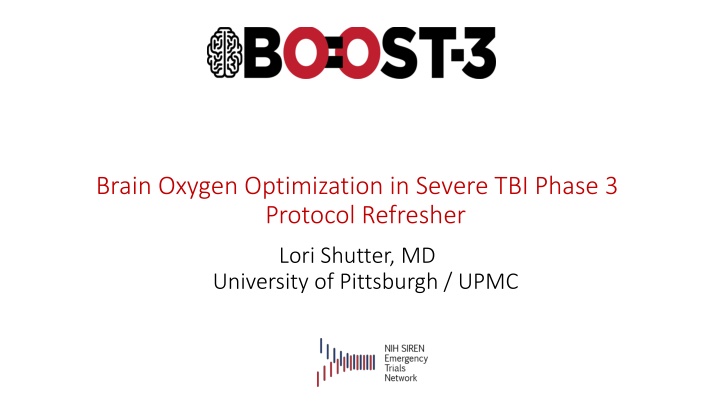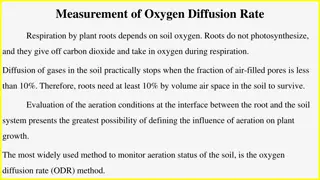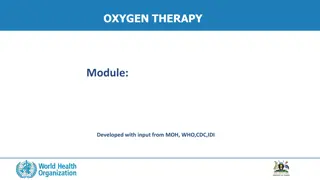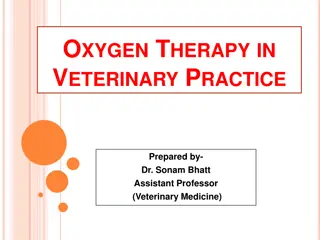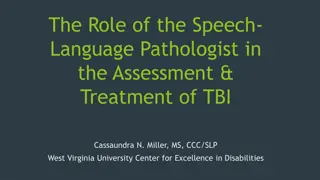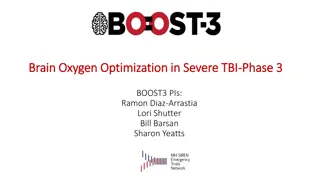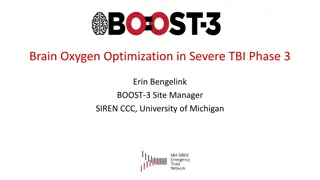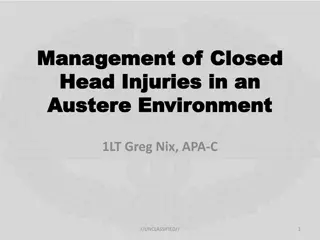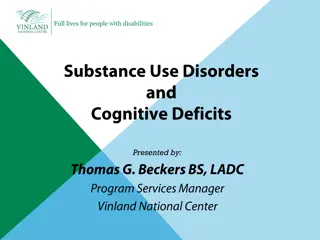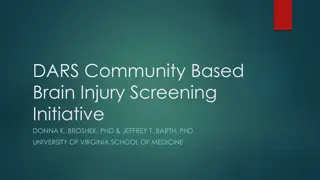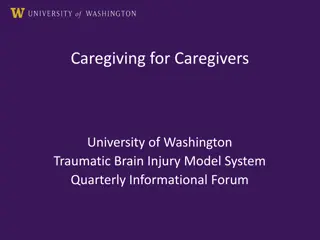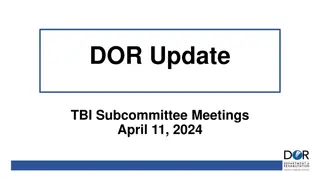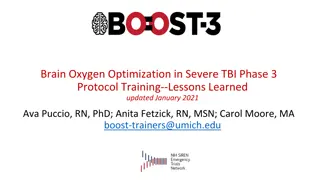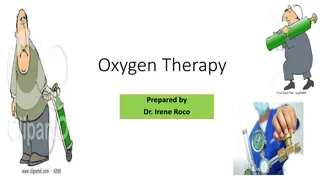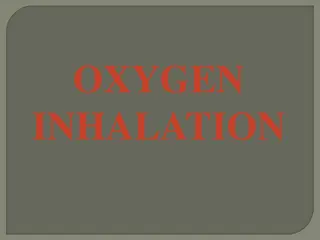Brain Oxygen Optimization in Severe TBI - Protocol Summary
In the severe traumatic brain injury (TBI) protocol, intracranial monitors measuring ICP and PbtO2 are placed within 12 hours of injury. Procedures include FiO2 challenges to check PbtO2 reliability and assess cerebral physiology. Challenges involving FiO2, MAP, and CO2 help guide ventilator settings and assess cerebral autoregulation. Monitoring and managing data reliability are crucial in optimizing brain oxygen levels for TBI patients.
Download Presentation

Please find below an Image/Link to download the presentation.
The content on the website is provided AS IS for your information and personal use only. It may not be sold, licensed, or shared on other websites without obtaining consent from the author.If you encounter any issues during the download, it is possible that the publisher has removed the file from their server.
You are allowed to download the files provided on this website for personal or commercial use, subject to the condition that they are used lawfully. All files are the property of their respective owners.
The content on the website is provided AS IS for your information and personal use only. It may not be sold, licensed, or shared on other websites without obtaining consent from the author.
E N D
Presentation Transcript
Brain Oxygen Optimization in Severe TBI Phase 3 Protocol Refresher Lori Shutter, MD University of Pittsburgh / UPMC
Intracranial Monitors ICP and PbtO2 monitors will be placed at the same time per local placement practices. The monitors should be placed as soon as possible after injury, and should be placed within 12 hours after injury and within 6 hours of arrival at the enrolling hospital. A single head CT will be obtained within 24 hours, per local standard of care, and after placement of the monitors to confirm location / assess for placement associated adverse events. CT images will be de-identified and collected centrally for future analysis.
Procedures To Check Reliability of PbtO2 Measurements Calibration of device will be checked according to manufacturer s instructions Prior to Insertion Each participant will have an FiO2 challenge within 2 hours after catheter placement Recorded measurements will be initiated 60 minutes after placement of monitor Treatment staff will be blinded to results in control arm FIO2 Challenge FiO2 Challenge will be repeated daily until probe is removed. Study staff may request a challenge at any time if they suspect the PbtO2 probe is not working. Repeated Challenges
FiO2, MAP, and CO2 Challenges FiO2 challenge: assesses probe reliability & provides information on both cerebral and systemic physiology. Guides ventilator settings, provides insight on lung physiology MAP challenge: helps assess cerebral autoregulation. Guides both MAP and CPP goals CO2 challenge: can assess cerebral CO2 vasoreactivity to guide ventilator adjustments, may provide input regarding potential hyperemia. Can use either hyperventilation or hypoventilation based on the clinical situation
Checking Reliability of PbtO2 Data: FiO2 Challenge Only the research team will be able to see the results of the challenge in the blinded ICP-only group. How to perform the challenge 1. Increase FiO2 to 100% for 20 minutes or until PbtO2 increases by 5 mm Hg, whichever occurs first. If the PbtO2 increases, you have confirmed accuracy of the PbtO2 readings. If the FiO2 challenge fails, repeat the challenge in about 1 hour. If the challenge fails again, further management will be determined by patient group. 2. Document time and results of the challenge
Trouble shooting a failed FiO2 Challenge (Intervention Arm) 1. Check peripheral O2 Sat did it respond to the challenge? May need an ABG to fully assess - if peripheral O2 sat was 100% at start you have no room to show improvement, so the ABG can give you more specific data. 2. Head CT to look at position and assess for air or blood near tip 3. Check Hgb and Lactate is the patient under resuscitated? Do they need more volume in the form of PRBCs? 4. Is the patient hemodynamically stable? What is CPP and MAP? Do they need a higher BP for better perfusion? 5. If all of these things are ok, then entertain the thought that the probe is not functioning and consider replacing it vs more time to stabilize.
Checking Reliability of PbtO2 Data: FiO2 Challenge In the treatment group, if there is a non-functioning or mal-positioned probe, or contusion expansion that results in inability to obtain PbtO2 values, a new PbtO2 probe should be placed within 2 hours if possible. In the ICP only group, the study team will document that the PbtO2 probe is unreliable. The medical staff and PI will not be notified that the probe is not functioning. The PbtO2 probe will not be replaced but it should be checked daily by the study team in the event that it begins to record data again. It should remain in place until the removal criteria has been met.
Removal or Replacement of Probes In general, ICP and PbtO2 probes will be removed by Day 5 Continued monitoring is allowed if clinically indicated. Replacement of a PbtO2 probe will only be considered in the ICP + PbtO2 group. Probes may be removed before 5 days in the following situations: A. The participant awakens from coma (motor GCS score = 6). B. There is a medical indication for removal (ie, infection; associated bleeding). C. No abnormalities of ICP for 72 hours after injury in the ICP only arm D. No abnormalities of ICP or PbtO2 are noted for 72 hours after injury in the ICP + PbtO2 arm E. Withdrawal of care If a probe is removed, the reason will be documented in the CRF An intent to treat analysis will be used.
Clinical Standardization Guidelines Physiologic parameter goals are in line with recommendations by the Brain Trauma Foundation and the American College of Surgeons Clinical management of these parameters should be based on local protocols and tracked on the daily CRFs PaO2, PaCO2, and pH levels will be monitored at least daily This information will be collected immediately after any FiO2 challenge and whenever an ABG is drawn for clinical management Hemodynamic Issues Arterial Blood Pressure monitoring for CPP purposes will be standardized to the level of the heart
Clinical Standardization Targets Physiologic Variable MOP Desired Value Pulse Ox > 94% PaO2 80 - 200 mmHg PaCO2 35 45 mmHg pH 7.35-7.45 >100 mmHg if 50 to 69 yo OR >110 mmHg if 15 - 49 or > 70 yo SBP If values are outside of these ranges and the clinical team chooses not to treat, then the treating physician must document rationale for leaving value outside of range. Temperature 36.5 37.5 C Maintain Normovolemia ICP < 22 mmHg CPP 60 mmHg PbtO2 > 20 mmHg Na 135-145 OR for HTS rx 145 - 160 mmol/L Glucose 80 180 mg/dL PT & PTT normal range per local hospital guidelines INR 1.6 Hemoglobin 7 gm/dl 80 x 103/mm3 Platelets
Clinical Standardization Guidelines: Seizure Prevention / Management Use of prophylactic anti-seizure medications (AEDs) is optional If prophylactic AEDs are initiated, they should be used for 7 days only unless there is evidence of seizure development. Phenytoin, levetiracetam, or other AEDs may be used for prophylaxis based on local protocol If phenytoin is chosen, a loading dose of 20 mg/kg should be given followed by a maintenance dose of 3 - 5 mg/kg/day in divided doses AED levels should be monitored per site protocol Clinical or subclinical seizures (as identified by EEG) should be managed according to site protocol. An AE form should be submitted to reflect onset, duration, and treatment of any seizure
Withdrawal of Care / Brain Death The intent of the study is to optimize therapy for 5 days after randomization. Withdrawal of care during the first 5 days may be considered in dire circumstances or if requested by the patient s family. The site PI will call the study hotline to update the study leadership team about withdrawal of care for a subject. Withdrawal of care will be documented on the End of Study form, and at the bedside on the Moberg monitoring device. Should the patient progress to brain death, determination is per local protocol. Participation in the clinical trial will not preclude a patient from consideration as an organ donor.
Management of elevated ICP and/or low PbtO2 Types of events ICP < 22 mm Hg ICP > 22 mm Hg Type A Type B PbtO2 > 20 No interventions directed at PbtO2 or ICP needed Interventions directed at lowering ICP Type C Type D PbtO2 < 20 Interventions directed at increasing PbtO2 Interventions directed at lowering ICP and increasing PbtO2
Scenario Based Patient Management Elevations in ICP > 22 mm Hg, or a decline in PbtO2 < 20 mm Hg, which are sustained for more than 5 minutes will trigger an intervention. Treatments must be initiated within 15 minutes of the start of the episode, as detected by the continuous ICP and PbtO2 recordings. Participants may start in one type of episode and move to another. Therapy will depend on which type of episode they are in at any given time. For ICP only group, only Type A and Type B episodes are relevant. For ICP + PbtO2 group, any of the 4 scenarios (Type A, B, C, or D).
Scenario Based Patient Management Therapeutic strategies are divided into tiers and organized in a hierarchical fashion Aggressiveness of interventions increase as you move through the tiers Goal: minimize treatment variability across sites while respecting local protocols and expertise Treatment interventions within any one tier can be attempted in any order or combination. At least one treatment in Tier 1 must be tried before moving on to Tier 2. It is not necessary to use all treatments in the tier, but it is expected that at least one intervention from each tier will be used before proceeding to the next tier. Tier 3 treatments are optional.
Scenario Based Patient Management The initial choice of a treatment option from any tier should be determined based on what may be the most effective for the current clinical situation, participant characteristics and local protocols. Any intervention chosen should be aimed at addressing the underlying pathophysiology that is contributing to each individual episode. For any treatment chosen, a rapid response to that treatment is expected. Should a treatment not be effective in a timely fashion, additional interventions within the same tier may be attempted, or a decision may be made to quickly move to the next tier.
Scenario Based Patient Management While there is no maximum number of treatment options that can be attempted from any one tier, no more than 60 minutes should be spent trying interventions within any single tier prior to moving on to the next tier. The bedside treatment team has the option to progress to higher tiers as rapidly as they feel is clinically indicated. Episode is considered over once normal values have been present for 30 minutes
Scenario B: ICP>22; PbtO2>20 Adjust head of bed to lower ICP Initiate or titrate anti-seizure medications; consider EEG Adjust analgesia OR sedation: Titrate to effect. Tier 1 Interventions: Treatment must begin within 15 minutes of ICP abnormality that is sustained for 5 minutes CSF drainage if EVD is available; titrate to effect. Adjust ventilator for target PaCO2 35-40mmHg, and target pH 7.35 7.45 Ensure temperature is < 38oC; treat hyperthermia Hyperosmolar therapy: Low dose Mannitol (0.25 0.5 g/kg) or Hypertonic Saline
Hyperosmolar Therapy Notes Mannitol: may also use more frequent lower dose mannitol (0.25 0.5 g/kg); keep serum osm < 320 mOsm HTS: may repeat, keep serum Na levels <160 mEq/L. Scenario B: ICP>22; PbtO2>20 Hyperosmolar Therapy High dose mannitol (1.0 1.5 g/kg) Hypertonic Saline bolus (30 ml of 23.4%). Adjust temperature to 35 36oC using active cooling measures Neuromuscular Blockade with short acting agents Tier 2 Interventions: Treatment must begin within 60 minutes if ICP is still >22 Treat surgically remediable lesions according to guidelines Hyperventilationto PCO2 goal 33 38 mmHg and target 7.35 7.45
Scenario B: ICP>22; PbtO2>20 Tier 3 Interventions (optional) Pentobarbital coma, per local protocol. Notes: Use an initial bolus of 5 mg/kg to determine if effective. If the bolus is effect, a continuous infusion may be used. Pentobarbital should be rapidly weaned upon clinical stabilization Decompressive craniectomy Adjust temperature to 32-35 C, using active cooling measures. Adjust ventilatory rate: target PaCO2 of 30 - 35 mm Hg while maintaining a pH less than 7.5 Other salvage therapy per local protocol & practice patterns.
Scenario C: ICP<22 PbtO2<20 Adjust head of the bed to improve brain oxygen level Initiate or titrate anti- seizure medications Ensure Temperature < 38oC; Treat fever Adjust ventilator rateto a PaCO2 38-42 mmHg while maintaining target pH 7.35 7.45 Tier 1 Interventions: Treatment must begin within 15 minutes of PbtO2 abnormality that is sustained for 5 minutes Optimize CPP upto 70 mm Hg with fluid bolus or vasopressors PaO2 adjustments: (obtain ABG before treating with PaO2 adjustments) Optimize hemodynamics Increase FiO2 up to 60%. Resuscitation - address hypovolemia to achieve euvolemia with volume per local protocol Diuresis- avoid hypervolemia, consider furosemide or diuretic Pulmonary toilet including suctioning of secretions Adjust PEEP by a max of 5 cm H20 over baseline; monitor ICP response
Scenario C: ICP<22 PbtO2<20 PaO2 adjustment: (obtain ABG ) Increase FIO2 up to 100% Adjust PEEP in increments of 3 5 cm H2O; monitor ICP response Perform bronchoscopy Adjust ventilator rate: target PaCO2 of 40 45mmHg while maintaining pH 7.35 7.45 Neuromuscular blockade with short acting agents Tier 2 Interventions: Treatment must begin within 60 minutes if PbtO2 is still < 20 Transfuse PRBC; document post-transfusion Hgb and PaO2 on CRF Increase CPP above 70 mm Hg with fluids or vasopressors. Increase sedation Decrease ICP to <15mmHg CSF drainage
Scenario C: ICP<22; PbtO2<20 Tier 3 Interventions (optional) Increase cardiac output with inotropes (milrinone, dobutamine) Assess for vasospasm with TCDs, CTA, or DSA. Hyperventilation (per CO2 challenge) to address possible reverse Robin- Hood syndrome Adjust ventilatory rate: target PaCO2 to > 45 mm Hg, maintain a target pH of 7.30 7.45 Other salvage therapy per local protocol & practice patterns. Notes: Consider use of CO/CI monitoring per local protocol if starting inotropes. Notes: If present, treat with augmentation of CPP. Notes: only if ICP under control Notes: Consider other causes of low PbtO2, ie CSDs, PE, CST
Scenario D: ICP>22, PbtO2<20 Treatment for this group is primarily aimed at lowering ICP with a secondary focus on raising PbtO2 Hyperosmolar therapy: Low dose Mannitol (0.25 0.5 g/kg) or Hypertonic Saline Ensure Temperature < 38 C Treat fever Adjust head of the bed to lower ICP Adjust analgesia OR sedation; titrate to effect Adjust ventilator rateto a PaCO2 38-42 mmHg while maintaining target pH 7.35 7.45 Tier 1 Interventions: Treatment must begin within 15 minutes of abnormality that is sustained for 5 minutes CSF drainage if EVD available Initiate or titrate anti- seizure medications PaO2 adjustments: (obtain ABG before treating with PaO2 adjustments) Optimize CPP up to 70 mm Hg with fluid bolus or pressors Optimize hemodynamics using either: Increase FiO2 up to 60%. Pulmonary toilet Adjust PEEP Resuscitation Diuresis
Hyperosmolar Therapy Notes Mannitol: may also use more frequent lower dose mannitol (0.25 0.5 g/kg); keep serum osm < 320 mOsm HTS: may repeat, keep serum Na levels <160 mEq/L. Scenario D: ICP>22; PbtO2<20 Hyperosmolar Therapy High dose mannitol (1.0 1.5 g/kg) Hypertonic Saline bolus (30 ml of 23.4%). Neuromuscular blockade with short acting agents Transfuse PRBC; document post- transfusion Hgb and PaO2 on CRF Tier 2 treatment must begin within 60 minutes if PbtO2 and ICP remain abnormal Adjust temperature to 35 36oC using active cooling measures PaO2 adjustment: (obtain ABG ) Increase FIO2 up to 100% Adjust PEEP in increments of 3 5 cm H2O; monitor ICP response Increase CPP above 70 mmHg with fluid boluses or vasopressors. Perform bronchoscopy Treat surgically remediable lesions according to guidelines
Scenario D: ICP>22; PbtO2<20 Tier 3 Interventions (optional) Pentobarbital coma, per local protocol. Decompressive craniectomy Adjust temperature to 32-35 C, using active cooling measures. Increase cardiac output with inotropes (milrinone, dobutamine) Assess for vasospasm with TCDs, CTA, or DSA. Hyper- ventilation (per CO2 challenge) to address possible reverse Robin-Hood syndrome Other salvage therapy per local protocol & practice patterns. Notes: Determine effectiveness Rapidly wean upon stabilization Notes: If present, treat with augmentatio n of CPP. Notes: Consider other causes of low PbtO2, ie CSDs, PE, CST Notes: Consider use of CO/CI monitoring per local protocol if starting inotropes.
